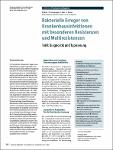Bakterielle Erreger von Krankenhausinfektionen mit besonderen Resistenzen und Multiresistenzen
Teil I: Diagnostik und Typisierung
Witte, Wolfgang
Strommenger, Birgit
Klare, Ingo
Werner, Guido
Für fast jede der therapeutisch gegen bakterielle Infektionserreger eingesetzten Antibiotikagruppen gibt es mehrere Einzelpräparate, die in der klinisch-bakteriologischen Routinediagnostik in der Empfindlichkeitsprüfung nicht erfasst werden können. Deshalb werden bei Kenntnis der Resistenzmechanismen und der daraus abzuleitenden Kreuzresistenzen bestimmte Testpräparate geprüft und das diesbezügliche Ergebnis im Sinne der Kreuzresistenz interpretiert. Diese Testpräparate entsprechen den Substanzen, die auch in den Ausführungen zu § 23 des Infektionsschutzgesetzes (IfSG) aufgeführt sind. Aufgrund der suboptimalen In-vitro-Expression verschiedener Resistenzmechanismen ist es erforderlich, neben den Routinemethoden (Agardiffusionstest, Mikrobouillon-MHK) ergänzende Tests einzusetzen, vorzugsweise durch Nachweis der Resistenzgene. Das Auftreten und besonders die Verbreitung antibiotikaresistenter Erreger von Krankenhausinfektionen können durch Erregertypisierung verfolgt werden. Bei der Auswahl der Typisierverfahren ist es erforderlich, Arbeitsaufwand, Diskriminierungsfähigkeit und Reproduzierbarkeit einzuschätzen. Zukünftig wird die Anwendung der Mikroarray-Technologie eine schnelle komplexe Diagnostik ermöglichen, die neben den Spezies-Eigenschaften und den Resistenzdeterminanten auch Virulenzassoziierte Gene einschließt. For use in human chemotherapy, there are several different substances for nearly each substance group available which cannot all be checked in routine susceptibility testing. If the bacterial resistance mechanisms and cross-resistance conferred by them are known, particular test substances can be selected and the results are interpreted on the basis of cross-resistance. Test substances correspond to those mentioned in guidelines for § 23 IfSG (German law on protection against infection). Due to suboptimal in vitro expression of different resistance mechanisms, it is necessary to perform additional tests besides routine agar-diffusion or microbroth MIC assays. These are preferentially tests for molecular demonstration of resistance genes.Emergence and spread of antibiotic-resistant nosocomial pathogens can be traced by typing. When selecting a typing method, it is important to assess work load, discriminatory power, and reproducibility. In future the availability of microarray technology will enable routine laboratories to demonstrate particular virulence-associated traits.
No license information
Related Items
Show related Items with similar Title, Author, Creator or Subject.
-
2013-07-12ZeitschriftenartikelDNA Uptake by the Nosocomial Pathogen Acinetobacter baumannii Occurs during Movement along Wet Surfaces Wilharm, Gottfried; Piesker, Janett; Laue, Michael; Skiebe, EvelynThe emergence of Acinetobacter baumannii as an increasingly multidrug-resistant nosocomial pathogen largely relies on acquisition of resistance genes via horizontal gene transfer. Here, we demonstrate that many clinical ...
-
2015-04-01ZeitschriftenartikelCapsules, Toxins and AtxA as Virulence Factors of Emerging Bacillus cereus Biovar anthracis Brézillon, Christophe; Haustant, Michel; Dupke, Susann; Corre, Jean-Philippe; Lander, Angelika; Franz, Tatjana; Monot, Marc; Couture-Tosi, Evelyne; Jouvion, Gregory; Leendertz, Fabian; Grunow, Roland; Mock, Michèle E.; Klee, Silke; Goossens, Pierre L.Emerging B. cereus strains that cause anthrax-like disease have been isolated in Cameroon (CA strain) and Côte d’Ivoire (CI strain). These strains are unusual, because their genomic characterisation shows that they belong ...
-
2011-09-08ZeitschriftenartikelRare Occurrence of Methicillin-Resistant Staphylococcus aureus CC130 with a Novel mecA Homologue in Humans in Germany Cuny, Christiane; Layer, Franziska; Strommenger, Birgit; Witte, WolfgangMRSA CC130 containing the mecA homologue mecALGA251 were reported from the UK and from Denmark so far from cattle and humans. Here we report on 11 MRSA CC130 among a sample of 12691 isolates of human origin collected from ...

